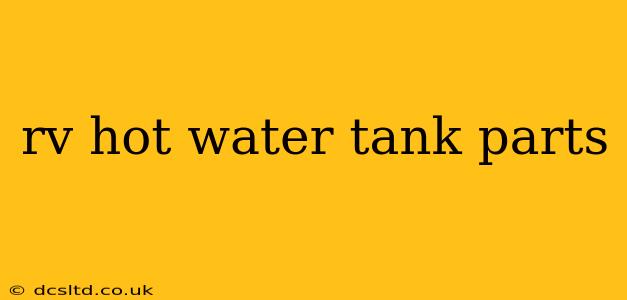Replacing or repairing your RV hot water tank can feel daunting, but understanding the individual parts makes the process much more manageable. This guide breaks down the key components of an RV hot water tank, explaining their function and helping you troubleshoot potential issues. Whether you're a seasoned RVer or a newbie, this guide will equip you with the knowledge to maintain your hot water system efficiently.
What are the main components of an RV hot water tank?
An RV hot water tank, while seemingly simple, comprises several crucial parts working together. These include:
-
Tank: This is the main cylindrical vessel holding the water, typically made of stainless steel or other corrosion-resistant materials. The size varies depending on your RV's needs, ranging from 6 gallons to 10 gallons or more. Inspecting the tank for leaks, rust, or damage is crucial for preventative maintenance.
-
Heating Element: This is the component responsible for heating the water. Most RV water heaters use electric heating elements, though some models also incorporate propane gas heating elements. A faulty heating element is a common cause of hot water issues.
-
Thermostat: This regulates the water temperature, preventing overheating and ensuring consistent hot water supply. A malfunctioning thermostat can lead to either lukewarm water or scalding temperatures.
-
Anode Rod: This sacrificial rod protects the inner tank from corrosion. It gradually dissolves, preventing the tank itself from rusting. Regular inspection and replacement of the anode rod are essential for extending the lifespan of your hot water tank.
-
Pressure Relief Valve: This safety device releases excess pressure to prevent explosions. It's crucial for safety and should be checked regularly to ensure it functions correctly. Testing involves lightly lifting the lever; a small amount of water should release.
-
Water Inlet Valve: This valve controls the flow of cold water into the tank. Problems with this valve can prevent the tank from filling properly.
-
Water Outlet Valve: This valve regulates the flow of hot water out of the tank. A malfunctioning outlet valve can lead to inconsistent hot water delivery.
-
Drain Valve: This valve allows you to drain the water from the tank for cleaning, maintenance, or winterizing.
How do I know which parts I need to replace?
Diagnosing the problem requires careful observation. Is there no hot water at all? Is the water lukewarm? Is there a leak? The symptoms will often point to the faulty component.
What if my RV hot water heater isn't heating?
This could indicate a problem with the heating element, thermostat, or even the power supply. Check the fuses and breakers first. If everything checks out, the heating element or thermostat likely needs replacing.
What if my RV hot water tank is leaking?
Leaks usually originate from the tank itself (due to corrosion or damage) or the pressure relief valve. Inspect the tank carefully for cracks or rust. If the tank is damaged, replacement is usually necessary. If the leak is from the pressure relief valve, a replacement is recommended.
What are the common causes of an RV hot water tank failure?
Common causes include: corrosion due to hard water or lack of anode rod maintenance, overheating due to a faulty thermostat, pressure build-up from a malfunctioning pressure relief valve, and physical damage.
How often should I replace my RV hot water tank anode rod?
This depends on several factors, including water hardness and usage. However, it's generally recommended to inspect the anode rod annually and replace it every 2-3 years, or sooner if significant corrosion is observed. A severely corroded anode rod will no longer protect the tank.
How do I winterize my RV hot water tank?
Winterizing is crucial to prevent damage from freezing temperatures. This involves draining the tank completely and using RV antifreeze to protect against freezing. Consult your RV's manual for specific winterization instructions.
By understanding the individual parts of your RV hot water tank and their functions, you'll be better equipped to maintain and repair your system, ensuring hot showers on the road. Remember, regular inspection and proactive maintenance are key to avoiding costly repairs down the line.
